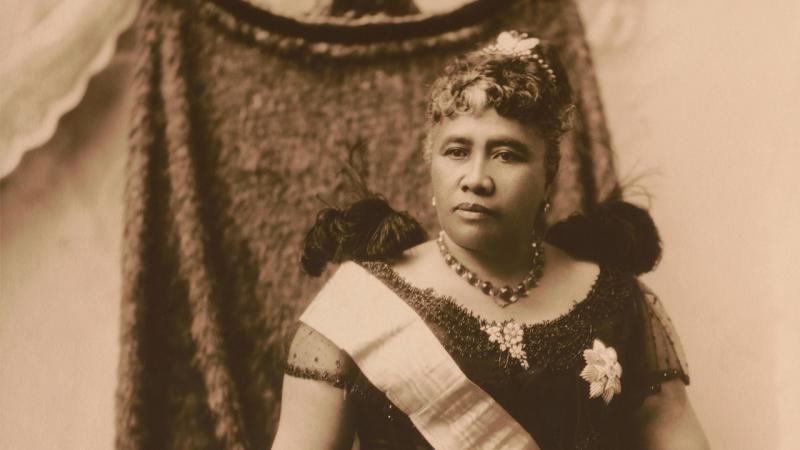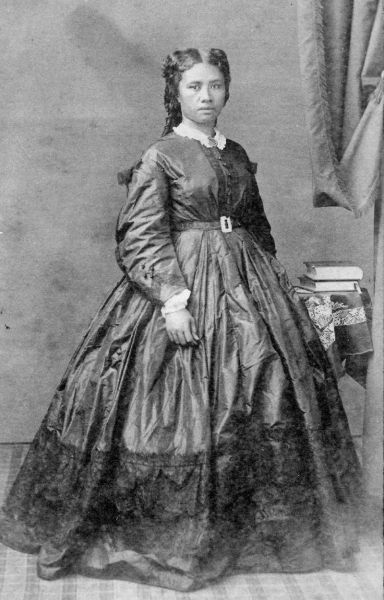Digital Collections
Celebrating the breadth and depth of Hawaiian knowledge. Amplifying Pacific voices of resiliency and hope. Recording the wisdom of past and present to help shape our future.
Kīhei de Silva
In the late 1960s, Mary Kawena Pukui recorded a series of "little Hawaiian verses for children." Her collection included mele for learning the alphabet and the multiplication tables, for playing hide and seek, for remembering the names of the districts of Ka‘ū, for teasing sullen playmates, and for making string figures. Her purpose, she explained, was preservation. She hoped that Hawaiian children would learn these mele and experience some of the things she enjoyed when she was a child. Implicit in her words was the belief that these little verses and the world they describe would otherwise be lost to us. "I don’t know if children today play the polepole, but we used to play polepole," she says before reciting the chant "Polepole Kama Malihini." Well, children today don’t, and neither did their parents. But with Kawena’s introductory remarks and song, we can certainly teach the now-forgotten hand game to our grandchildren.
In 1999, Mountain Apple released these thirty-seven mele on the NHCAP-sponsored compact disc Mary Kawena Pukui, No nā Kamali‘i. The last of Kawena’s selections is what we now recognize as the exit chant "Halehale ke Aloha i Ha‘ikū / Keawe ‘O‘opa." It’s obvious that she selected this mele because it brought her "performance" to an appropriate close and signaled her departure from the audio stage. But Kawena had something more in mind: a ha‘awina for her older listeners. Before leaving, she explains that "Halehale ke Aloha"—later known as "Keawe ‘O‘opa"—was originally a children’s string chant—and that it was gradually adapted and absorbed into the repertoires of po‘e hula.
[The old words] were used with a string game. Then, in time, it changed. And now we have a hula called "Keawe ‘O‘opa." "Kāne‘opā" [of the original] became "Keawe ‘O‘opa." The words were made, then, into a hula chant and usually danced at the end of a program. Then the last version was given as a surf chant to the last ruler of Hawai‘i nei: Kamaka‘eha Lili‘uokalani. We have this chant. Many of us have danced it. The words have been changed here and there, but most are the same as with the string game.
The original "Hele i ke Aloha Ai Ku," as given by Kawena, tells the story of a man who goes off in pursuit of aloha ‘aikū—of love without ceremony or restriction.
Hele i ke aloha ai ku
Eia la e aniani mai kona aloha
Maluna mai o Awili pu
Ke pi‘i la kai o Kape‘a
Kai pi‘i wale i ka pali
Kai ‘au‘au o ka mea aloha
Go to the unceremonious love
Of she who gently beckons with her hand, a love token
From above Awili—together.
It gently rises, the sea at Kape‘a
The sea softly washing against the cliff
The sea, bathing place of the beloved one
There is no cripple in Kawena’s mele hei, no Keawe-the-lame who hitches, in anguish, along the shoreline. Instead, we have a man whose affection "stirs in him like an eel," who "bundles up his clothes," and who finds satisfaction with his loved one in the metaphorical drenching of feathers and bubbling of sea foam beneath the rain-drenched cliffs of Kane‘ōpā.
Kuau ka ‘ope‘ope i Waimalino
Kū ‘ululū ka hulu o ka manu
I ka ua pēhi mai ma ka pali o Kane ‘ōpā
Ka ne‘ene‘e i kahakai me ka hu‘ahu‘a
Floating his bundled clothes to Waimalino.
Drenched are the feathers of the bird
By the rain beating down on the pali of Kaneopa,
Moving seaward with the foam[1]
I can understand how the string chant’s description of a man’s journey from kapu to noa would have caught the ears of attentive po‘e hula and inspired a hula ho‘i adaptation. With a deft shift of venue and perspective, they used "Hele i ke aloha ‘aikū" to suggest the metaphorical journey from sacred to secular that occurs at the end of a hula performance. As hula ho‘i, the revised mele speaks of the lifting of kapu that follows a performance; it anticipates the release of dancer and audience to their ‘aikū lives and pursuits.
It is not as easy to understand why Keawe ‘O‘opa and the surf-riding Kamaka‘eha were worked into the ensuing adaptation of the mele. This Keawe is something of an enigma to me. I haven’t been able to identify him as either historical or legendary, nor do I have a sure sense of the thinking behind his transformation from cliff to cripple. His presence, however, definitely adds drama to the mele. The subject of the "Keawe ‘O‘opa" is no longer an unnamed man on his way to a lovers’ rendezvous. Instead, he is Keawe ‘O‘opa on his way to cleanse himself of the anguish caused by aloha kāwalawala—by unrequited love.
More drama awaits us at the conclusion of the mele: as Keawe creeps along the kahakai, Kamaka‘eha suddenly appears at the base of a wave and rides it all the way to him. This sounds to me like Keawe is on the verge of rescue and renewal, like Kamaka‘eha will now heal his distress and restore his strength. But I can’t be sure because the mele goes no further; it ends without denouement at: "A pae ‘o Kamaka‘eha i ka nalu! And Kamaka‘eha rides the wave to shore!"
I can, of course, take a guess at what’s going on. The crippled Keawe may be an allusion to the Kamehameha line of ruling chiefs—descendants of Keawe‘īkekahiali‘iokamoku—whose mana has diminished over time and whose salvation now rests in the hands of a new leader. Keawe drags himself to the sea where he is met by Lydia Lili‘u Kamaka‘eha, ka mea e pae i ka nalu, she who masters the surf. Hope rides with her for the renewal of nation and lāhui.
Alternately, Keawe might be a reference to Kalākaua, Lili‘u’s own brother, whose power in the last years of his reign could easily have been characterized as ‘o‘opa—crippled, lame. The name, in this interpretation, can be seen as a short form of Keaweaheulu, great-grandfather of Lili‘u and Kalākaua through their mother Keohokālole. Kalākaua—the old Keawe—limps to the sea. Kamaka‘eha—the new Keawe—emerges from the surf. Again, hope rides with Lili‘u for the return of sacredness and power to the nation.
With these possibilities in mind, I can also venture a guess as to why Lili‘u’s "Keawe ‘O‘opa"—though identified by Kawena as a surf chant—continued to be performed as a mele hula ho‘i. The mele, I suggest, is a ho‘i hanakaulua—a "double-duty" ho‘i whose significance rests in the paired meanings of ho‘i as departure and return. Dancers leave the stage with this mele, they ho‘i from kapu to noa. But in leaving, they call for the return, the ho‘i, of the undiminished kapu of old in the person of Kamaka‘eha.[2] After 1893, it is possible that "Keawe ‘O‘opa" was even performed as a hidden call for Lili‘u’s restoration to the throne. The events of the closing decade of the 19th century would have added fuel to the kaona of "a pae ‘o Kamaka‘eha i ka nalu," and po‘e hula of the period may have used the mele to deliver a political and spiritual statement that they could not express outright in public.
Kaona of this nationalist sort may have been delivered, back then, by knowledgeable performers to select members of their audience, but it has long since faded from our contemporary understanding of the composition. Today, "Keawe ‘O‘opa" is learned by rote and performed with little awareness of its origins in a string chant or its possible evolution into a statement of political resistance. Perhaps Kawena’s ha‘awina in No Nā Kamali‘i was meant to stir us out of our complacency.
Keawe ‘O‘opa
Halehale ke aloha a i Ha‘ikū ē
Aniani mai ana kona aloha
Ma luna mai a‘o ‘Āwilikū
Ke po‘i a ke kai a‘o Kape‘a
Kai ‘au‘au a ka mea aloha
Kona aloha kāwalawala
‘Oni ana i ka manawa me he puhi ala
Kū‘ululū e ka hulu o ka manu
‘I ka ua pehia mai i ka pali
‘O Keawe, ‘o Keawe, ‘o Keawe ‘o‘opa
Ne‘ene‘e nei ma kahakai
‘O Kamaka‘eha ka honua nalu
A pae ‘o Kamaka‘eha i ka nalu.
Deep, deep is the love at Ha‘ikū
Where the loved one beckons
From the heights of ‘Āwilikū,
Below, the sea of Kape‘a dashes against the cliffs,
This is the bathing place of the beloved
Her love is unsettling, insufficient
And squirms in the manawa like an eel[3]
Chilled are the feathers of the bird
By the rain beating against the cliffs
It is Keawe, Keawe, Keawe-the-crippled-one
Hitching along at the seashore
It is Kamaka‘eha at the base of the breaking wave
And Kamaka‘eha rides the wave to shore.
References:
Notes:


photo courtesy of: Hawaiʻi State Archives
The name given, at birth, to Lili‘uokalani was Lili‘u (smarting) Loloku (tearful) Walania (burning pain) Kamaka‘eha (the sore eye); it commemorated the painful eye infection suffered at that time by high chiefess Kīna‘u. Lili‘u wrote in her diary that she was not very fond of the name "Lili‘uokalani" which was given to her by Kalākaua in 1877 when he named her heir apparent.